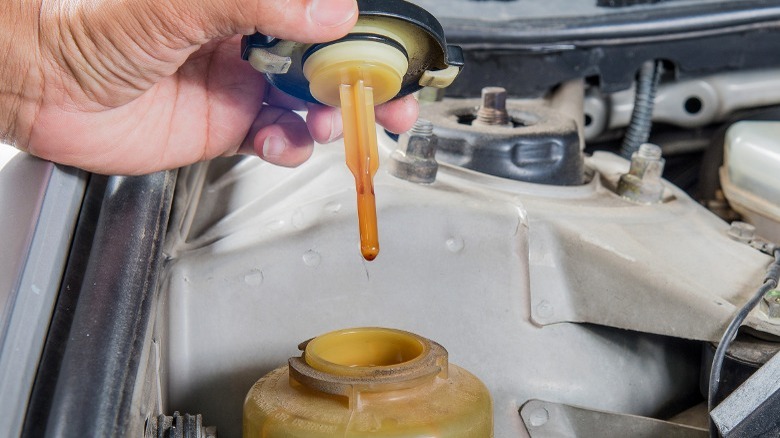What Color Is Power Steering Fluid? (And Why It Might Change)
If you've ever tried to steer a modern car or truck while it's powered off and shifted into neutral, you know how much more difficult it is to turn those front wheels than it is when the engine is running. That's because in everyday driving, much of the work of keeping the vehicle in its lane or turning is done by a power steering system that amplifies the movements of the steering wheel made by the driver.
In many vehicles, the steering assist comes in the form of a hydraulic system. Power steering uses a pump, driven by a belt connected to the engine, to push hydraulic power steering fluid through the system. That pressure applies more force to the steering assembly than the driver, making it easier to turn the wheels.
There are three types of fluids used for this system: automatic transmission fluid (literally the same liquid that the automatic transmission uses), a specialized synthetic fluid, or a mineral-based hydraulic fluid. There's a container of it under the hood, and it's a good idea to check it periodically because what goes on inside that reservoir — from the amount of fluid to its color — is a good indicator of the health of your power steering system.
Troubleshooting by fluid color
New power steering fluid is transparent and usually amber, red, or pink in color. As it operates in a closed system, the reservoir's fluid level should remain close to constant. If the level drops, that means there's a leak somewhere. This fluid helps drivers turn the wheels and lubricates the steering system so parts don't grind themselves up. Through the months and miles, the fluid can degrade or collect dust, grime, and other liquids. This changes the fluid's color or, more worryingly, its consistency.
Even under normal driving conditions, the fluid can turn brown or even black if left unchanged for too long. It's important to replace the fluid when it's turning a darker color, or you may end up with a car that squeaks when you turn the steering wheel.
Fluid that loses its clarity and turns foamy or milky-colored can indicate that water or air has gotten into the system, making the fluid less effective or even causing damage to your power steering system. In this instance, it should be flushed from the system and replaced. Milky or foamy fluid is also a sign the power steering system needs service by a mechanic to figure out how it became contaminated.
If the fluid changes consistency, it should be flushed and the system inspected — especially if you see bits of particulate or silver slivers in the reservoir. When power steering fluid loses its ability to lubricate due to age or contamination, it allows internal parts of the steering system to wear on each other and grind off slivers of metal.
What happens when you don't change the fluid regularly?
It's important to follow your particular vehicle's maintenance schedule, but a general rule of thumb is to flush and replace the power steering fluid between about 40,000 and 80,000 miles. Leaving old or bad fluid in the system will make the pump work harder, and you (and others around you) may even start to hear it complain as it gets louder or squeaks. The pump may even start to grind itself up and shed metal bits into the fluid, potentially damaging other parts of the system.
Bad fluid –- or not enough good fluid — can also cause a car to be more difficult to steer. Adding fluid when the reservoir is low is only helpful if the fluid in the reservoir isn't already degraded or contaminated. If it's past its prime, adding more likely won't fix the steering difficulty. The old power steering fluid should be flushed and replaced.
One of the best maintenance tips you can easily do at home is to check your vehicle's fluid levels and colors regularly. It'll help you spot and fix trouble early and potentially save a lot of money on repairs.


